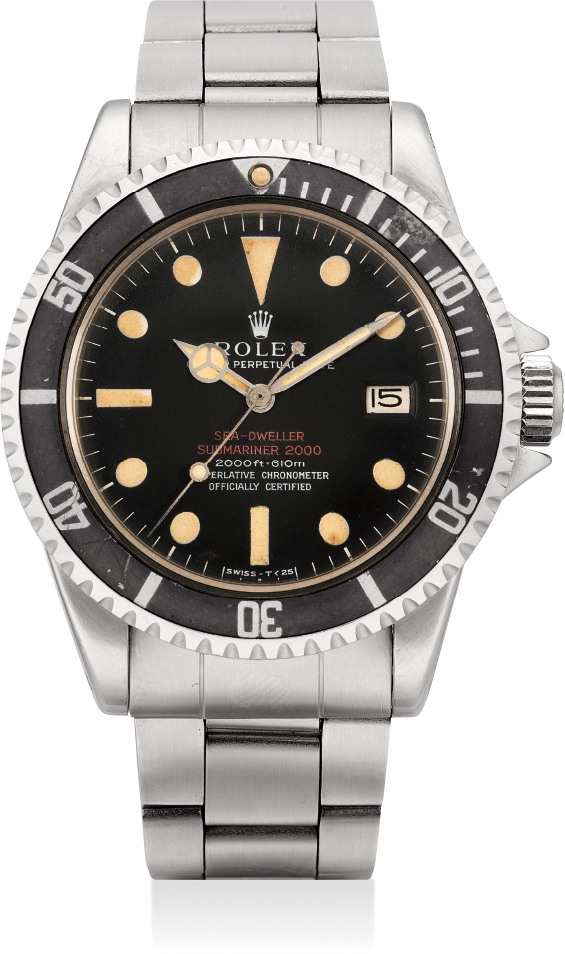

953
Rolex
Ref. 1665
Sea-Dweller
A fine, very early, extremely rare and highly important stainless steel automatic diver's wristwatch with no gas-escape valve, center seconds, date and bracelet
Full-Cataloguing
In its essence, the Sea-Dweller is basically an upgraded Submariner. Its history begins in the mid-1960s. At the time, a number of international experiments where developed with the goal of demonstrating the possibility of living for an extended period of time (sometimes weeks) in underwater habitats. Rolex was approached and started to develop timepieces which would resist very deep dives and underwater habitat condition. The result was a series of watches which sported characteristics such as improved water resistance capabilities - up to 2000 ft underwater - a helium escape valve and the date indication. All these features were specifically developed for the highly technical and unusual conditions of these experiments. The reason for improved water resistance is quite apparent.
The helium escape valve was included because when working in helium-rich atmospheres, the tiny helium molecules would bleed through the gasket into the watch, and created pressure once back to the surface with the result of popping the crystal; the valve was meant to prevent this issue by letting - unsurprisingly - the gas escape. The date was an attempt to reduce the disorientation caused by the lack of sunlight. While common knowledge has the development of these watches being prompted by French company Comex, it was actually a number of institutions which spoke with Rolex regarding such timepieces. For example, the scientists of American underwater habitat Tektite wore such watches in 1969 and 1970, and the same is true for the scientists working at the Sealab III experiment. The name Sea-Dweller itself is a direct nod to the fact that the model had been developed to meet the demands of scientists leaving - or “dwelling” - under the sea. Following the positive results obtained with these companies, Rolex went on to publicly commercialize the model, with advertising material from the 1970s highly emphasizing the professional genesis of the watch.
What is truly remarkable is that different habitats required different technical solutions. The Sealab III habitat was located at 185m and featured a helium saturated environment, thus needed a valve. However, the Tektite habitat was located at just 15m underwater, and needed no valve. Consequently, some of the very first iterations of the Seadweller, most probably developed indeed for the Tektite experiment, were produced without the helium escape valve, making them, from a technical point of view, the true “missing link” between the Submariner and the Sea-Dweller. Such examples of ref. 1665 are astoundingly rare to come by: according to our research, less than 10 pieces are known overall.These pieces bear serial numbers between 1.6 and 1.8 million, with the earliest example known so far being number 1’602’91x, issued to Tektite I dweller Ian Koblick. These No Valve 1665 are usually known with the single red Sea-Dweller dial. However, scholarly research has also identified few examples, such as the present watch, bearing a Double Red dial. This variety of dials in such a relatively short time span is the consequence of the "prototype status” of these timepieces, which were not serially made, and mostly manufactured and issued - before their commercialization - on the occasion of a specific scientific endeavor or for test purposes.
The existence of these watches is testament to the “trial-and-error” methodology Rolex adopted at the time when evaluating potential candidates for mass production and commercialization. It is obvious that eventually the valve design was deemed more successful and thus was selected for subsequent iterations. Such a choice will later even result in the modification (with the addition of the valve) of some reference 5513 pieces and subsequently the existence of the valve-bearing reference 5514, both of them Submariner models made for COMEX.
The present watch is offered by an important Japanese collector, who informs us the original provenance of the piece is the USA, and it came to Japan through an itnermediary. This detail adds substance to the conjecture that these No Valve models have been made for the American experiment “Tektite”.
The piece can undoubtedly be considered an absolute jewel in the panorama of vintage watch collecting: its extreme scarcity is fully matched by the importance for the history of Rolex, as it represents one of the earliest incarnations of one of their most successful models. Furthermore, it is one of the earliest examples of a wristwatch scientifically developed, under request of a scientific institution, to withstand very specific and strict requirements dictated by a highly demanding environment. Truly an outstanding piece of the history of the Crowned House.
We are deeply indebted to scholars John Goldberger, Jatucka and Jose Pereztroika for their invaluable assistance during the research of this timepiece.
Rolex
Swiss | 1905Founded in 1905 England by Hans Wilsdorf and Alfred Davis as Wilsdorf & Davis, it soon became known as the Rolex Watch Company in 1915, moving its headquarters to Geneva in 1919. Like no other company, the success of the wristwatch can be attributed to many of Rolex's innovations that made them one of the most respected and well-known of all luxury brands. These innovations include their famous "Oyster" case — the world's first water resistant and dustproof watch case, invented in 1926 — and their "Perpetual" — the first reliable self-winding movement for wristwatches launched in 1933. They would form the foundation for Rolex's Datejust and Day-Date, respectively introduced in 1945 and 1956, but also importantly for their sports watches, such as the Explorer, Submariner and GMT-Master launched in the mid-1950s.
One of its most famous models is the Cosmograph Daytona. Launched in 1963, these chronographs are without any doubt amongst the most iconic and coveted of all collectible wristwatches. Other key collectible models include their most complicated vintage watches, including references 8171 and 6062 with triple calendar and moon phase, "Jean Claude Killy" triple date chronograph models and the Submariner, including early "big-crown" models and military-issued variants.